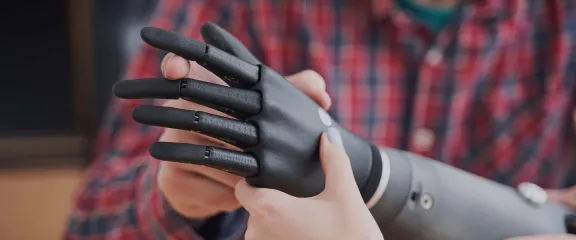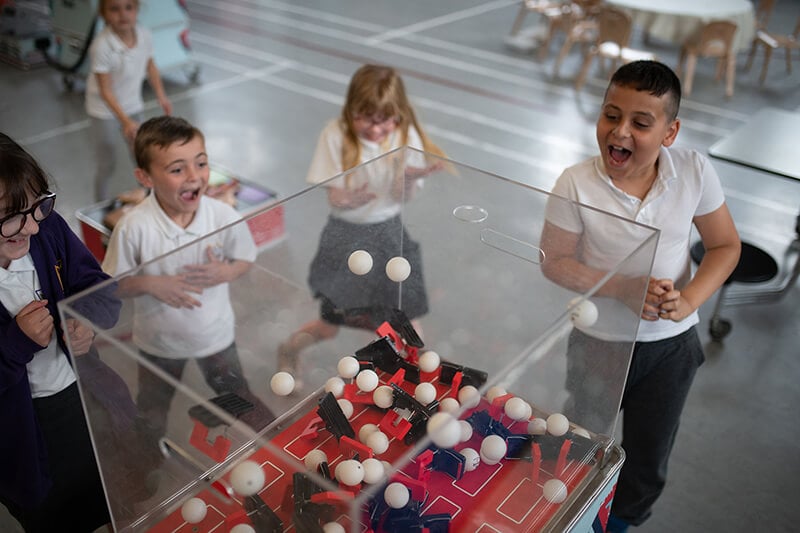Uncovering the mystery of Phantom Limb Pain

This week we’re looking at a medical condition where the exact cause is yet to be clearly understood, and which affects thousands of people in the UK. Nicole Alexander from Glasgow Science Centre has been finding out about phantom limb pain and how technology can help.
What is Phantom Limb Pain?
Phantom Limb Pain (PLP) is the perception of pain or discomfort amputees feel resonating from their missing limb. The pain is described as shooting or stabbing pains. Heat, pressure, cramping, itchy and crushing sensations are also reported.
Of the thousands of amputees in the UK every year roughly 85-90 % experience PLP to some degree. The pain can begin as early as a week after amputation and can last years. The pain is usually intermittent and can disappear or lessen over time with the right treatment. However, PLP can have a devastating effect on mental and physical health.
Understanding what causes PLP
PLP was first described in the 16th century by pioneering French army surgeon; Ambroise Paré. Notable sufferers include Lord Admiral Nelson who lost his arm in a 1797 naval battle via a musket ball. Lord Nelson reported feeling his missing fingers pressing into his missing palm. However, the term Phantom Limb Pain wasn’t coined until the 19th century by an American Civil War surgeon: Silas Weir Mitchell. Mitchell coined the term in his study of the fate of Civil War amputees.
Over four centuries later, modern science still has no definitive answer to what exactly causes PLP. A prevailing theory is that after amputation the brain and spinal cord lose input from the missing limb, the brain tries to adjust to this detachment by sending out our most basic signal that something is not right: pain. In its confusion the brain might send sensory information to another part of the body, for example, the amputees cheek. Many people report feeling their phantom limb touching another part of the body, like the phantom hand on their cheek.
Proprioception
Another theory is to do with proprioception. Proprioception is your awareness of where your body is in space, a body map. It’s the reason you can close your eyes and touch your nose with accuracy. Proprioception plays a vital role in balance and orientation. When a limb is amputated the region of the brain controlling the missing limb can’t reconnect. This causes the brain to send messages to the residual traumatised muscle tissue and nerves resulting in ‘spontaneous discharges’ of pain.
As well as debating the causes of PLP science has also been searching for ways to diminish the pain. One of the most popular treatments is known as: mirror therapy. Invented by Dr Vilayanur Ramachandran in the mid-1990’s mirror therapy is genius in its simplicity. It works by placing a mirror in front of the intact limb while hiding the missing limb behind it. The patient would do simple exercises with their intact limb while watching it move in the reflection. By doing this daily, the patient will potentially ‘trick the brain’ into thinking their body is whole. This visual ‘input’ should gradually change the brain’s ‘output’ signals of pain. Although mirror therapy has been reported to lessen sufferers pain it does not cure it. Patients describe it as; ‘short term. More of a salve than a cure’.
Prosthetics
Prosthetic devices can also act as a therapeutic technique for managing PLP. Scotland has historically led the way in the advancement of bioengineering and prosthetics. In 1998, Robert Campbell Aird received the world’s first bionic arm from the Princess Margaret Rose Hospital in Edinburgh. Aird wore a cap which contained sensors to pick up the electrical impulses his brain was sending to his missing limb. These signals were detected by microchips in the prosthetic arm, which allowed Aird to control its movement.
Glasgow Science Centre’s BodyWorks exhibition has a “mirror box” and bionic limbs which lets you explore these therapies more.
Virtual Reality and Phantom Limb Pain
Looking even further into the future for a cure there are few things more futuristic than Virtual Reality (VR). Innovators are looking to VR to solve real world problems such as PLP. In these sessions amputees would wear VR glasses whilst having motion sensors attached to the base of the amputated limb. These sensors would send signals to the glasses which would then be translated into movement. The visuals would create a more realistic looking missing limb.
In the virtual world anything is possible; amputees can lift a glass with their missing arm or run on their missing leg. Initial trials with this experimental therapy have demonstrated positive results for patients and while more work is needed to investigate VR as a way of managing PLP, it gives us an intriguing insight into what this technology is capable of.
Further information
This blog post, written by Nicole Alexander from Glasgow Science Centre, is adapted from an article that first appeared in Glasgow Times in June 2022.
You may also be interested in...
Can you tie your shoelaces without looking at your feet? Proprioception is how your body knows which position it is in and how it is moving. In this GSC At Home video, Celine presents some simple exercises aimed at over 5s to test how your brain works out what you are doing with your arms and legs.





